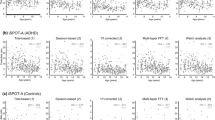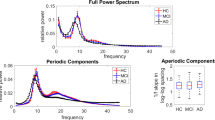Abstract
Huntington’s disease (HD) is a devastating neurodegenerative disorder with prominent motor and cognitive decline. Previous studies with small sample sizes and methodological limitations have described abnormal electroencephalograms (EEG) in this cohort. The aim of the present study was to investigate objectively and quantitatively the neurophysiological basis of the disease in HD patients as compared to normal controls, utilizing EEG mapping. In 55 HD patients and 55 healthy controls, a 3-min vigilance-controlled EEG (V-EEG) was recorded during midmorning hours. Evaluation of 36 EEG variables was carried out by spectral analysis and visualized by EEG mapping techniques. To elucidate drug interference, the analysis was performed for the total group, unmedicated patients only and between treated and untreated patients. Statistical overall analysis by the omnibus significance test demonstrated significant (p < 0.01 and p < 0.05) EEG differences between HD patients and controls. Subsequent univariate analysis revealed a general decrease in total power and absolute alpha and beta power, an increase in delta/theta power, and a slowing of the centroids of delta/theta, beta and total power. The slowing of the EEG in HD reflects a disturbed brain function in the sense of a vigilance decrement, electrophysiologically characterized by inhibited cortical areas (increased delta/theta power) and a lack of normal routine and excitatory activity (decreased alpha and beta power). The results are similar to those found in other dementing disorders. Medication did not affect the overall interpretation of the quantitative EEG analysis, but certain differences might be due to drug interaction, predominantly with antipsychotics. Spearman rank correlations revealed significant correlations between EEG mapping and cognitive and motor impairment in HD patients.




Similar content being viewed by others
References
Alper KR, John ER, Brodie J, Gunther W, Daruwala R, Prichep LS (2006) Correlation of PET and qEEG in normal subjects. Psychiatry Res 146:271–282
Anderer P, Saletu B, Kinsperger K, Semlitsch H (1987) Topographic brain mapping of EEG in neuropsychopharmacology—Part I. Methodological aspects. Methods Find Exp Clin Pharmacol 9:371–384
Anderer P, Semlitsch HV, Saletu B, Barbanoj MJ (1992) Artifact processing in topographic mapping of electroencephalographic activity in neuropsychopharmacology. Psychiatry Res 45:79–93
Anderer P, Saletu B, Pascual-Marqui RD, Semlitsch HV (2000) EEG and ERP topography and tomography in normal aging. In: Saletu B, Krijzer F, Ferber G, Anderer P (eds.) Electrophysiological brain research in preclinical and clinical pharmacology and related fields—an update. Facultas, Wien, pp 122–138
Babiloni C, Binetti G, Cassarino A, Dal Forno G, Del Percio C, Ferreri F, Ferri R, Frisoni G, Galderisi S, Hirata K, Lanuzza B, Miniussi C, Mucci A, Nobili F, Rodriguez G, Luca Romani G, Rossini PM (2006a) Sources of cortical rhythms in adults during physiological aging: a multicentric EEG study. Hum Brain Mapp 27:162–172
Babiloni C, Binetti G, Cassetta E, Dal Forno G, Del Percio C, Ferreri F, Ferri R, Frisoni G, Hirata K, Lanuzza B, Miniussi C, Moretti DV, Nobili F, Rodriguez G, Romani GL, Salinari S, Rossini PM (2006b) Sources of cortical rhythms change as a function of cognitive impairment in pathological aging: a multicenter study. Clin Neurophysiol 117:252–268
Bellotti R, De Carlo F, Massafra R, de Tommaso M, Sciruicchio V (2004) Topographic classification of EEG patterns in Huntington’s disease. Neurol Clin Neurophysiol 2004:37
Bente D (1977) Vigilance: psychophysiologic aspects. Verh Dtsch Ges Inn Med 83:945–952
Berardi AM, Parasuraman R, Haxby JV (2005) Sustained attention in mild Alzheimer’s disease. Dev Neuropsychol 28:507–537
Boulougouris V, Tsaltas E (2008) Serotonergic and dopaminergic modulation of attentional processes. Prog Brain Res 172:517–542
Bronnick K, Ehrt U, Emre M, De Deyn PP, Wesnes K, Tekin S, Aarsland D (2006) Attentional deficits affect activities of daily living in dementia-associated with Parkinson’s disease. J Neurol Neurosurg Psychiatry 77:1136–1142
Bylsma FW, Peyser CE, Folstein SE, Folstein MF, Ross C, Brandt J (1994) EEG power spectra in Huntington’s disease: clinical and neuropsychological correlates. Neuropsychologia 32:137–150
Cross EM, Chaffin WW (1982) Use of the binomial theorem in interpreting results of multiple tests of significance. Educ Psychol Measurement 42:25–34
de Tommaso M, De Carlo F, Difruscolo O, Massafra R, Sciruicchio V, Bellotti R (2003) Detection of subclinical brain electrical activity changes in Huntington’s disease using artificial neural networks. Clin Neurophysiol 114:1237–1245
Dierks T, Perisic I, Frolich L, Ihl R, Maurer K (1991) Topography of the quantitative electroencephalogram in dementia of the Alzheimer type: relation to severity of dementia. Psychiatry Res 40:181–194
Eisen A, Bohlega S, Bloch M, Hayden M (1989) Silent periods, long-latency reflexes and cortical MEPs in Huntington’s disease and at-risk relatives. Electroencephalogr Clin Neurophysiol 74:444–449
Folstein MF, Folstein SE, McHugh PR (1975) “Mini-mental state”. A practical method for grading the cognitive state of patients for the clinician. J Psychiatr Res 12:189–198
Foster DB, Bagchi BK (1949) Electroencephalographic observations in Huntington’ s chorea. Electroencephalogr Clin Neurophysiol 1:247–248
Gasser T, Bacher P, Mocks J (1982) Transformations towards the normal distribution of broad band spectral parameters of the EEG. Electroencephalogr Clin Neurophysiol 53:119–124
Gianotti LR, Kunig G, Lehmann D, Faber PL, Pascual-Marqui RD, Kochi K, Schreiter-Gasser U (2007) Correlation between disease severity and brain electric LORETA tomography in Alzheimer’s disease. Clin Neurophysiol 118:186–196
Gordon EB, Sim M (1967) The E.E.G. in presenile dementia. J Neurol Neurosurg Psychiatry 30:285–291
Head H (1923) The conception of nervous and mental energy. II. Vigilance: a physiological state of the nervous system. Br J Psychol 14:125–147
Hughes SW, Crunelli V (2005) Thalamic mechanisms of EEG alpha rhythms and their pathological implications. Neuroscientist 11:357–372
Huntington Study Group (1996) Unified Huntington’s disease rating scale: reliability and consistency. Mov Disord 11:136–142
Hutchison WD, Dostrovsky JO, Walters JR, Courtemanche R, Boraud T, Goldberg J, Brown P (2004) Neuronal oscillations in the basal ganglia and movement disorders: evidence from whole animal and human recordings. J Neurosci 24:9240–9243
Jackson CE, Snyder PJ (2008) Electroencephalography and event-related potentials as biomarkers of mild cognitive impairment and mild Alzheimer’s disease. Alzheimers Dement 4:S137–S143
Kassubek J, Bernhard Landwehrmeyer G, Ecker D, Juengling FD, Muche R, Schuller S, Weindl A, Peinemann A (2004a) Global cerebral atrophy in early stages of Huntington’s disease: quantitative MRI study. Neuroreport 15:363–365
Kassubek J, Juengling FD, Kioschies T, Henkel K, Karitzky J, Kramer B, Ecker D, Andrich J, Saft C, Kraus P, Aschoff AJ, Ludolph AC, Landwehrmeyer GB (2004b) Topography of cerebral atrophy in early Huntington’s disease: a voxel based morphometric MRI study. J Neurol Neurosurg Psychiatry 75:213–220
Kwak YT (2006) Quantitative EEG findings in different stages of Alzheimer’s disease. J Clin Neurophysiol 23:456–461
Mann DM, Oliver R, Snowden JS (1993) The topographic distribution of brain atrophy in Huntington’s disease and progressive supranuclear palsy. Acta Neuropathol 85:553–559
Margerison JH, Scott DF (1965) Huntington’s chorea: clinical, EEG and neuropathological findings. Electroencephalogr Clin Neurophysiol 19:314–316
Mattia D, Babiloni F, Romigi A, Cincotti F, Bianchi L, Sperli F, Placidi F, Bozzao A, Giacomini P, Floris R, Grazia Marciani M (2003) Quantitative EEG and dynamic susceptibility contrast MRI in Alzheimer’s disease: a correlative study. Clin Neurophysiol 114:1210–1216
McGuinness B, Barrett SL, Craig D, Lawson J, Passmore AP (2010) Attention deficits in Alzheimer’s disease and vascular dementia. J Neurol Neurosurg Psychiatry 81:157–159
Noth J, Engel L, Friedemann HH, Lange HW (1984) Evoked potentials in patients with Huntington’s disease and their offspring. I. Somatosensory evoked potentials. Electroencephalogr Clin Neurophysiol 59:134–141
Pascual-Marqui RD, Michel CM, Lehmann D (1994) Low resolution electromagnetic tomography: a new method for localizing electrical activity in the brain. Int J Psychophysiol 18:49–65
Pascual-Marqui RD, Lehmann D, Koenig T, Kochi K, Merlo MC, Hell D, Koukkou M (1999) Low resolution brain electromagnetic tomography (LORETA) functional imaging in acute, neuroleptic-naive, first-episode, productive schizophrenia. Psychiatry Res 90:169–179
Patterson RM, Bagchi BK, Test A (1948) The prediction of Huntington’s chorea; an electro-encephalographic and genetic study. Am J Psychiatry 104:786–797
Rosas HD, Liu AK, Hersch S, Glessner M, Ferrante RJ, Salat DH, van der Kouwe A, Jenkins BG, Dale AM, Fischl B (2002) Regional and progressive thinning of the cortical ribbon in Huntington’s disease. Neurology 58:695–701
Rosas HD, Koroshetz WJ, Chen YI, Skeuse C, Vangel M, Cudkowicz ME, Caplan K, Marek K, Seidman LJ, Makris N, Jenkins BG, Goldstein JM (2003) Evidence for more widespread cerebral pathology in early HD: an MRI-based morphometric analysis. Neurology 60:1615–1620
Saletu B (1997) Visualizing the living human brain. The techniques and promise of EEG and event-related potentials mapping. In: Judd L, Saletu B, Filip V (eds) Basic and clinical science of mental and addictive disorders. Bibliotheca Psychiatrica, vol 167. Karger, Basel, pp 54–62
Saletu B (2000) Pharmacodynamics and EEG. I. From single-lead pharmaco-EEG to EEG mapping. In: Saletu B, Krijzer F, Ferber G, Anderer P (eds) Electrophysiological brain research in preclinical and clinical pharmacology and related fields—an update. Facultas Universitätsverlag, Wien, pp 139–156
Saletu B, Grunberger J (1985) Memory dysfunction and vigilance: neurophysiological and psychopharmacological aspects. Ann N Y Acad Sci 444:406–427
Saletu B, Anderer P, Paulus E, Grunberger J, Wicke L, Neuhold A, Fischhof PK, Litschauer G (1991a) EEG brain mapping in diagnostic and therapeutic assessment of dementia. Alzheimer Dis Assoc Disord 5(Suppl 1):57–75
Saletu B, Anderer P, Paulus E, Grunberger J, Wicke L, Neuhold A, Fischhof PK, Litschauer G (1991b) EEG brain mapping in diagnostic and therapeutic assessment of dementia. Alzheimer Dis Assoc Disord 5(Suppl 1):S57–S75
Saletu B, Anderer P, Saletu-Zyhlarz GM, Arnold O, Pascual-Marqui RD (2002) Classification and evaluation of the pharmacodynamics of psychotropic drugs by single-lead pharmaco-EEG, EEG mapping and tomography (LORETA). Methods Find Exp Clin Pharmacol 24(Suppl C):97–120
Saletu B, Anderer P, Saletu-Zyhlarz GM, Pascual-Marqui RD (2005) EEG mapping and low-resolution brain electromagnetic tomography (LORETA) in diagnosis and therapy of psychiatric disorders: evidence for a key–lock principle. Clin EEG Neurosci 36:108–115
Schreiter-Gasser U, Gasser T, Ziegler P (1994) Quantitative EEG analysis in early onset Alzheimer’s disease: correlations with severity, clinical characteristics, visual EEG and CCT. Electroencephalogr Clin Neurophysiol 90:267–272
Scott DF, Heathfield KW, Toone B, Margerison JH (1972) The EEG in Huntington’s chorea: a clinical and neuropathological study. J Neurol Neurosurg Psychiatry 35:97–102
Sishta SK, Troupe A, Marszalek KS, Kremer LM (1974) Huntington’s chorea: an electroencephalographic and psychometric study. Electroencephalogr Clin Neurophysiol 36:387–393
Sprengelmeyer R, Lange H, Homberg V (1995) The pattern of attentional deficits in Huntington’s disease. Brain 118(Pt 1):145–152
Steriade M, Amzica F (1998) Slow sleep oscillation, rhythmic K-complexes, and their paroxysmal developments. J Sleep Res 7(Suppl 1):30–35
Streletz LJ, Reyes PF, Zalewska M, Katz L, Fariello RG (1990) Computer analysis of EEG activity in dementia of the Alzheimer’s type and Huntington’s disease. Neurobiol Aging 11:15–20
van der Hiele K, Jurgens CK, Vein AA, Reijntjes RH, Witjes-Ane MN, Roos RA, van Dijk G, Middelkoop HA (2007) Memory activation reveals abnormal EEG in preclinical Huntington’s disease. Mov Disord 22:690–695
Van Sweden B, Wauquier A, Niedermeyer E (1999) Normal aging and transient cognitive disorders in the elderly. In: Niedermeyer E, Da Silva FL (eds) Electroencephalography: basic principles, clinical applications and related fields, 4th edn. Williams & Wilkins, Baltimore, pp 340–348
Acknowledgments
The authors would like to express their thanks to Josef Diez, MD, and Franz Reisecker, MD, Department of Neurology, Barmherzige Brüder Hospital of Graz, for their cooperative assistance in this project. Furthermore, we thank Mag. Elisabeth Grätzhofer, Department of Psychiatry, Medical University of Vienna, for her valuable editorial assistance.
Conflict of interest
The authors have no conflict of interest to declare.
Author information
Authors and Affiliations
Corresponding author
Rights and permissions
About this article
Cite this article
Painold, A., Anderer, P., Holl, A.K. et al. Comparative EEG mapping studies in Huntington’s disease patients and controls. J Neural Transm 117, 1307–1318 (2010). https://doi.org/10.1007/s00702-010-0491-7
Received:
Accepted:
Published:
Issue Date:
DOI: https://doi.org/10.1007/s00702-010-0491-7




